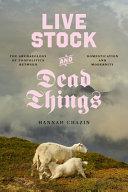[Read] PDF/Book Live Stock and Dead Things: The Archaeology of Zoopolitics between Domestication and Modernity (Animal Lives)Hannah Chazin

Ebook PDF Live Stock and Dead Things: The Archaeology of Zoopolitics between Domestication and Modernity (Animal Lives) | EBOOK ONLINE DOWNLOAD
If you want to download free Ebook, you are in the right place to download Ebook. Ebook/PDF Live Stock and Dead Things: The Archaeology of Zoopolitics between Domestication and Modernity (Animal Lives) DOWNLOAD in English is available for free here
[Download] Link : [Downlload Now] Live Stock and Dead Things: The Archaeology of Zoopolitics between Domestication and Modernity (Animal Lives)
Read More : [Read Now] Live Stock and Dead Things: The Archaeology of Zoopolitics between Domestication and Modernity (Animal Lives)
Description
Reconceptualizes human-animal relationships and their political significance in ancient and modern societies. In Live Stock and Dead Things, Hannah Chazin combines zooarchaeology and anthropology to challenge familiar narratives about the role of non-human animals in the rise of modern societies. Conventional views of this process tend to see a mostly linear development from hunter-gatherer societies, to horticultural and pastoral ones, to large-scale agricultural ones, and then industrial ones. Along the way, traditional accounts argue that
owning livestock as property, along with land and other valuable commodities, introduced social inequality and stratification. Against this, Chazin raises a provocative question: What if domestication wasn't the origin of instrumentalizing non-human animals after all? Chazin argues that these conventional narratives are inherited from conjectural histories and ignore the archaeological data. In her view, the category of "domestication" flattens the more complex dimensions of humans' relationship to herd animals. In the book's first half, Chazin offers a new understanding of the political possibilities of pastoralism, one that recognizes the powerful role herd animals have played in shaping human notions of power and authority. In the second half, she takes readers into her archaeological fieldwork in the South Caucasus, which sheds further light on herd animals' transformative effect on the economy, social life, and ritual. Appealing to anthropologists and archaeologists alike, this daring book offers a reconceptualization of human-animal relationships and their political significance.
